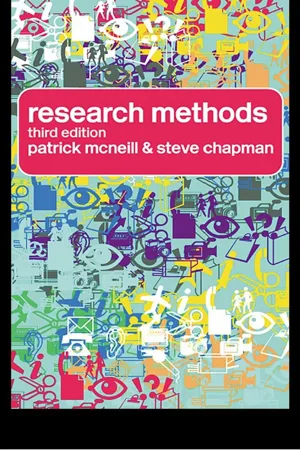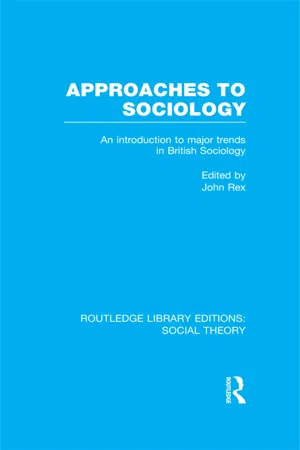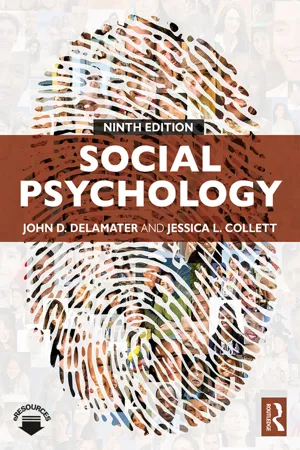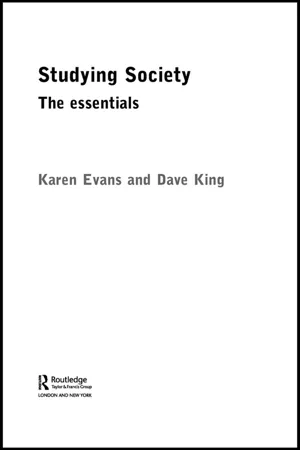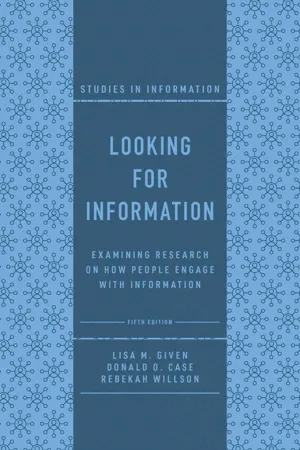Social Sciences
Research Methods in Sociology
Research methods in sociology refer to the systematic approaches used to investigate social phenomena and collect data for sociological studies. These methods include qualitative and quantitative techniques such as surveys, interviews, observations, and experiments. Researchers in sociology use these methods to gather and analyze information about human behavior, social structures, and cultural practices within society.
Written by Perlego with AI-assistance
Related key terms
10 Key excerpts on "Research Methods in Sociology"
- eBook - ePub
- Steve Chapman, Patrick McNeill, Patrick Mcneill(Authors)
- 2005(Publication Date)
- Routledge(Publisher)
1 Research Methods in Sociology‘What is sociology about?’ is probably the question that sociologists are asked more often than any other. A reasonable reply might be that sociologists are interested in those aspects of human behaviour which are the result of the social context in which we live. They do not concentrate on features which are the result of our physical or biological makeup. Sociology stresses the patterns and the regularities of social life which are, most of the time, orderly and largely predictable.The next question is then, typically, ‘But what do you actually do?’ and it is to this question that this book is addressed. While there is, as you may know, considerable variation and disagreement among sociologists, they are united in the conviction that argument that is based on sound evidence is superior to argument based on false evidence, limited evidence, or no evidence. Evidence has to be collected from the social world around us, and this requires empirical research to be done. ‘Empirical’, in this context, simply means ‘based on evidence from the real world’ in contrast to ‘theoretical’, which refers to ideas that are abstract or purely analytical. Theories must be tested against the real world, ‘Theory, in fact, is the building which is made from the hard-won bricks of research studies’ (Mann 1985). This still leaves open the question of what counts as sound evidence, and this in turn leads to a central theme of this book: ‘How can we collect sound evidence about the social world that can be used to increase our understanding of that world?’Over the years, sociologists have used a wide variety of methods of data collection and analysis. They have studied an even wider variety of aspects of social life, from such matters as how people avoid bumping into each other in the street to topics as wide-ranging as the causes of the rise of capitalism. In fact, a brief history of sociology since the end of the last century is an effective way of introducing the variety of research styles and some of the topics studied. - eBook - ePub
Approaches to Sociology (RLE Social Theory)
An Introduction to Major Trends in British Sociology
- John Rex(Author)
- 2014(Publication Date)
- Routledge(Publisher)
3 Current approaches to empirical research: some central ideas *Frank Bechhofer IntroductionThis chapter will attempt to provide a framework within which one can place many of the research methods being used in sociology today, and it will, hopefully, provide a way of understanding why these particular methods are used and what their strengths and weaknesses are. It certainly does not pretend to be an introduction to research per se; this would require far greater space, and there are a number of accounts already available which should be consulted in conjunction with this chapter.1 Moreover, it follows from my view of research methods that the student would be well advised to make it his practice to read widely in several texts. Our approach to, and understanding of, a particular method is influenced both by our general understanding of the task of sociology and by the theoretical orientation which we prefer. This is reflected in the research methods literature; thus Blalock’s An Introduction to Social Research2 clearly shows his interest in causal modelling and explanation, and hence a tendency to ignore many methods of data collection. Historical materials are never mentioned and participant observation hardly lends itself to this approach. Norman Denzin in The Research Act in Sociology3 operates very clearly from his symbolic interactionist perspective; his treatment of data collection methods is far more comprehensive, but the reader would get little idea that for some researchers measurement is a central social science problem, or that there is now a body of literature on causal analysis whose growth is so rapid that one sometimes speculates whether it is cancerous.4I am firmly of the opinion that the use of research methods would be vastly improved if sociologists made more effort to understand even those approaches which differ sharply from their own. Many of the existing textbooks do little to encourage this process, since their authors write purely from one perspective. I have little hope that this chapter will escape the problem; indeed, I would have considerable sympathy with the argument that it is intrinsically almost impossible. Nevertheless, I shall try to outline some of the ideas which seem to me to underly much sociological research method. Although there are very real differences, which I would not wish to minimise, between sociologists of varying philosophical and theoretical orientations, I am convinced that many of the more dismissive statements by both teachers and students are based on a comparative ignorance of the methods they are attacking. There is then concealed within this chapter a plea for a little more tolerance, and for criticism from a position of strength rather than weakness. This is no attempt at a comprehensive account. Neither does it lay any great claim to originality. I shall have achieved my aim if the reader acquires some general feel for the ways in which the greater part of empirical research is being carried out, and is stimulated to read and study further in this area. I have attempted to provide sufficient references to help this process. An important warning is perhaps necessary here. Many textbooks concern themselves with the description of idealised research processes rather than actual procedures. To some extent this chapter will fall into the same trap, and it should therefore be said at the outset that most research deviates greatly from the paths of righteousness.5 - eBook - ePub
- J. Holmwood, J. Scott, J. Holmwood, J. Scott, J. Holmwood, J. Scott(Authors)
- 2014(Publication Date)
- Palgrave Macmillan(Publisher)
19 Research Methodology in Sociology Geoff PayneDespite rated second only to America in the national sociology stakes by the Economic and Social Research Council’s (ESRC’s) 2010 International Subject Benchmarking Review, UK sociology has a track record of being more concerned, and confused, about research methodology than other social sciences. At the heart of this paradox is that today’s ‘big tent’ discipline is still recovering from being the new kid on the block. British sociology, and therefore British sociological research, developed ‘late’ (Chapter 8 ). This institutional framework determined what research was done, how it was conducted, and which ‘methods’ became routinised, when the small and relatively new discipline of sociology suddenly expanded in the 1960s. It was the combination of a small base with an extraordinarily large and rapid university expansion, at a unique point in intellectual history, which shapes our perceptions and practice of sociological research, and our uncertainties about it.This chapter therefore addresses methodology more as technical practice than epistemology (Marsh, 1979; Harding, 1987), seeing research as social processes, learned and carried forward by actors in rule-confined (albeit contested) social spaces. For instance, how we teach research reveals a lot about how we really see empirical research. ‘Empirical research’ here means acquiring and applying information about the social world in support of claims to sociological understanding, rather than in the specific sense of formal experiments or a narrow conception of ‘the’ scientific method. If this frustrates readers more interested in thinking and reading (and of course, reading and thinking are also essential precursors to data generation) I apologise, but we need definitional boundaries to disentangle ‘research’ from ‘sociology’. - No longer available |Learn more
- John D. DeLamater, Jessica L. Collett(Authors)
- 2018(Publication Date)
- Routledge(Publisher)
Social PsychologyIntroductionObjectives of Research Research Hypotheses Validity of FindingsCharacteristics of Empirical ResearchSurveys Diary Research Experiments Qualitative Methods Comparison of Research Methods Meta-AnalysisResearch MethodsResearch in Diverse PopulationsPotential Sources of Harm Institutional Safeguards Potential BenefitsEthical Issues in Social Psychological ResearchSummaryCritical Thinking Skill: Understanding the Importance of SamplingLearning Objectives
By the end of this chapter you will be able to:- Explain the four objectives of social psychological research and the nature of research hypotheses.
- Describe steps researchers take to increase the validity of their findings.
- Describe the defining characteristics of quantitative research methods such as surveys and experiments, and qualitative methods such as observation and archival research, and be able to compare them.
- Explain the issues that are raised when we undertake research on diverse groups within U.S. society or with members of other cultures.
- Understand the ethical issues that are important in the conduct of social psychological research, and describe the safeguards available to protect the rights of participants.
Introduction
Social psychology relies on empirical research, which is the systematic investigation of observable phenomena (behavior, events) in the world. Researchers try to collect information about behavior and events in an accurate and unbiased form. This information, which may be either quantitative or qualitative, enables social psychologists to describe reality in detail and to develop theories about social behavior.When conducting empirical research, investigators usually employ a methodology - eBook - ePub
Studying Society
The Essentials
- Karen Evans, Dave King(Authors)
- 2006(Publication Date)
- Routledge(Publisher)
Part IVResearching society
INTRODUCTION
In this book we are mainly concerned with locating knowledge or information that is already available in some form. At an undergraduate level you will not usually be expected to carry out original research although you might be asked to carry out a small project in order to learn how to conduct research. As well as providing a grounding for any future research that you might carry out, it is important for you to know something about research methods in order that you can make an informed evaluation of the methods used in the studies that you read.Quantity and quality
A common distinction made when discussing research methods in the social sciences is between quantitative and qualitative methods. Basically the distinction is a simple one: quantitative methods produce data that can be expressed in a numerical form, whereas qualitative methods produce data that can only be expressed in a non-numerical way. Whilst these methods have their roots in different philosophical positions and you will find some people who will argue for the superiority of one over the other, we would urge you to think in terms of the advantages and disadvantages of each.To begin with both approaches have a number of features in common: they both aim to explain or understand some aspect of social life and they try to do this by the systematic collection and analysis of empirical material.Passage contains an image
Chapter 14Quantitative research
Quantitative methods are typically associated with an approach known as positivism. - eBook - ePub
- Dr Derek Layder, Julia O'Connell Davidson(Authors)
- 2012(Publication Date)
- Routledge(Publisher)
The relationship between methodology and the research community has been identified by some philosophers of science, in particular Popper (1963), as the best guarantor of reliable, unbiased scientific knowledge. As academic researchers know (though this may not be so apparent to students and some other consumers of social research), there is a kind of ‘community’ which operates behind the scenes, and exerts a great deal of control over what kind of research gets done and what kind of research gets published. Obtaining funding for a research project entails drawing up a detailed research proposal which is then closely examined either by colleagues in the same or another university or by members of a funding body (such as the Economic and Social Research Council), people who usually have been, or are involved in academic research. Articles and research reports that are sent to journals for publication will generally be sent out to two or three ‘referees’ (academics working in the same field) for approval, as well as being read by the editor and members of the editorial board. Even books are scrutinised by other researchers. Academic publishers send drafts out to readers for comment and criticism. Once published, and if the researcher is fortunate, research receives yet more critical, public appraisal from the research community in the form of reviews, comment and criticism – even praise if the researcher is more fortunate still. This kind of detailed, critical scrutiny certainly has an impact on methodology, though, as we argue below, it does not necessarily eliminate or even reduce all types of bias.The methodological domain
It might be assumed that the term ‘methodology’ refers simply to the techniques - eBook - ePub
Completing Your EdD
The Essential Guide to the Doctor of Education
- Iona Burnell Reilly, Jodi Roffey-Barentsen(Authors)
- 2020(Publication Date)
- Emerald Publishing Limited(Publisher)
The important point for you to remember is that you have to understand how the research design choices you make will impact on the format of the data that you collect and the associated limitations. Your job as a doctoral student is to defend the choices that you make and be able to explain how you overcame some of the limitations.Reflective question:If you are considering using a qualitative methodology, reflect on how you will address the issues of your own subjectivity whilst in the field. What will you do to ensure you gather valid and reliable data? How will you minimise the influence of your own subjectivity when gathering data?Moving on, I now discuss the uses and limitations of research methods that are typically (but not exclusively) used in quantitative social science research: surveys and questionnaires. I then discuss the uses and limitations of typically qualitative research methods including interviews, focus groups, observations and ethnography. This is not an exhaustive list of methods, but they tend to be the most popular with doctoral students and that is why I have chosen them for discussion in this chapter.SURVEYS
In this section, we consider what a survey is and when it is appropriate in social science research to use a survey. Surveys and questionnaires are often confused with each as they can seem similar in terms of purpose and execution. However, a survey gathers quite different data to a questionnaire. By understanding when we use surveys and when we use questionnaires, it can be easier to understand the differences between them. Put simply, by understanding what each method does, it is far easier to not mix them up in the future. We use surveys in social science research to gather data for the following purposes:- To find out information about a population.
- To make inferences about ideas/behaviours/knowledge, etc. – it all depends upon what you want to know.
Surveys can be a useful and effective way to capture trends and attitudinal changes over time (Bryman, 2008 ; Newby, 2014 - eBook - ePub
- Jonathan Grix(Author)
- 2018(Publication Date)
- Bloomsbury Academic(Publisher)
inference underlying both types of enquiry, may be the same, rendering the sharp distinction between them that is often made a false one (Landman 2000: 19; Silverman 2000: 11). Equally, both qualitative and quantitative research must be understood as umbrella terms, under which a wide and diverse range of ‘paradigms, approaches to data, and methods for the analysis of data’ are categorised (Punch 2000: 139).Before highlighting the important debate surrounding mixing methods or ‘triangulation’, something you need to digest before embarking on your dissertation, thesis or project, I offer an overview of the most frequently used research methods in the human sciences, their potential and their limitations.Quantitative researchBroadly speaking, quantitative research is characterised by three basic phases: finding variables for concepts, operationalising them in the study and measuring them. This type of research approach tends, in general, to ‘abstract from particular instances to seek general description or to test causal hypotheses; it seeks measurements and analyses that are easily replicable by other researchers’ (King et al. 1994: 3). (Of course, not all quantification satisfies King’s statement, the use of quantitative methods in discourse analysis being a case in point.) The replication of methods is seen by supporters of quantitative analyses as very important, because the work is thus subject to verifiability, which provides an air of legitimacy, reproducibility, reliability and objectivity. Statistical reliability is sought by undertaking a random sample of cases (the more the better) from which generalisable results can be gleaned. Therefore, studies employing quantitative methods are more often than not carried out involving a number of cases or subjects, which are independent of context, or, to put it another way, they are studies in which the researcher does not physically interact with the subject of analysis. A case in point would be an analysis based on statistics of several countries’ welfare states. These statistics can be collated from various sources, without having to visit the countries involved. In this type of research, the researcher is said to be detached from the object of study (Neuman 2000: 16). Of course, no one can be fully detached from any type of research – or offer a value-free - eBook - ePub
Looking for Information
Examining Research on How People Engage with Information
- Lisa M. Given, Donald O. Case, Rebekah Willson(Authors)
- 2023(Publication Date)
- Emerald Publishing Limited(Publisher)
Finally, there must be an alignment between the paradigms, theories, research questions, methodologies, and methods used in a research study. Each aspect, separately, is important to the creation of a sound research design but there must also be an internal logic to the decisions made. Paradigms and theories offer ways of viewing the world, which should determine the types of research problems and topics that researchers explore, as well as the types of questions they ask of the world around them. In turn, hypotheses or research questions should determine the methodologies and methods used to collect and analyze the data used as evidence about the world around us. There are choices made about research on these multiple levels.5.1.2 Qualitative, Quantitative, and Mixed Research Designs
Research exploring people's information behaviors is often described as being qualitative (i.e., inductive), quantitative (i.e., deductive), or of a mixed research design. These studies may involve human participants (e.g., with data gathered via questionnaires or interviews), or they may explore the artifacts of human experience (e.g., social media posts). The common feature is their positioning of people's experiences as central to the investigation, rather than the primary focus being (for example) the information system (e.g., a database) or setting (e.g., a hospital) where the information behavior occurred. These other aspects are important contextual elements that may be considered in the study, but they are not the primary focus for information behavior investigations.Methodology is the framework that underpins and informs the research strategies and methods used in research designs. Methodology helps us to understand how investigations might be conducted, including how evidence may be gathered and analyzed to address research questions. As human-centered research approaches are diverse, and informed by varied assumptions about reality and knowledge, different methodologies enable different approaches to studying human experience.Most investigators have previously established assumptions and preferences that lead them to choose certain designs and techniques. A key consideration is whether they are proceeding inductively or deductively in their research design. Taking an inductive approach (typically aligned with qualitative designs) means that the research will examine particular instances and reason toward transferability of results. That is, a researcher is gathering, analyzing, and interpreting data in such a way that it may lead to general principles, such as theories. Grounded theory - eBook - ePub
- Gerald Handel(Author)
- 2018(Publication Date)
- Routledge(Publisher)
IIResearch Methods
IntroductionThere are many methods for studying families; each has its own purpose and its own underlying logic that justifies using the method. A full discussion of their variety requires a work of encyclopedic proportions (for example, Boss, Doherty, LaRossa, Schumm, & Steinmetz, 1993). Here we need only make use of a widely recognized distinction, that between quantitative (Wampler & Halverson, 1993) and qualitative (Rosenblatt & Fischer, 1993) methods.The most frequently used quantitative method is the sample survey (often shortened to “survey”), which focuses on specific behaviors or attitudes and on factors that are hypothesized to influence them. The chapter by Ross and Mirowsky illustrates survey research. The researcher designs a measure for each behavior or attitude and each potential explanatory factor. As a simple illustrative example, the researcher might expect that how much education a husband has influences how much housework he does. Education is easily measured in years and housework in hours per week, so a survey questionnaire can be designed for interviewing husbands on these matters. The goal is to understand whether such a relationship between education and housework exists for all husbands in the population; since they are too numerous, the researcher must interview an appropriately selected sample. By using suitable statistical procedures, the researcher can find out whether housework is related to education in the sample and whether the results in the sample can be generalized to the population. Measurement, statistical analysis, and generalization of findings from a sample to a population are the distinguishing features of quantitative research.
Index pages curate the most relevant extracts from our library of academic textbooks. They’ve been created using an in-house natural language model (NLM), each adding context and meaning to key research topics.
